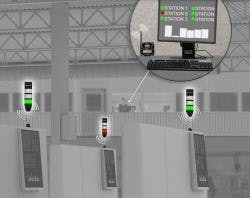For many manufacturers, the IIoT is enabling increased visibility into the performance and efficiency of their
machines, processes, and people, becoming a critical part of making better, data-driven business decisions.
Below I outline three ways that remote-monitoring technologies—particularly wireless and IO-Link devices—are revolutionizing industrial automation, offering manufacturers greater visibility into their operations, and facilitating better decision-making.
1. Remote condition monitoring enables predictive maintenance
Wireless sensor networks are increasingly used to help avoid machine failures by enabling predictive maintenance. With remote-condition monitoring, maintenance decisions can be made based on the historical and real-time data from the machine itself. For example, wireless vibration and temperature sensors can detect signs of misaligned, loose or worn parts on a machine. The wireless sensors then transmit that information to a wireless controller that makes data available immediately (via text or email alerts) and for long term analysis.
By monitoring machine components in real-time for increases in vibration and temperature, problems can be detected and resolved before they cause additional damage or result in unplanned downtime. Over time, historical data creates a valuable machine-performance log that can be used to make more informed maintenance decisions down the line.
Remote-condition monitoring is also becoming increasingly valuable for applications that require quick intervention to avoid downtime, including temperature and humidity monitoring and fill-level monitoring.
For example, wireless temperature monitoring can help ensure that ambient or process temperatures remain at appropriate levels to maintain product integrity (for example, during the manufacturing of heat-sensitive electronics or handling of refrigerated food products). If a threshold is reached (for example, if a process becomes too hot), an alert informs operators so that the situation can be resolved quickly, before extended downtime, scrapped materials or product recall.
Wireless ultrasonic sensors can be used to remotely monitor tank-fill levels to ensure tanks are refilled prior to running dry—and to avoid messy spills if tank level begins to run too high. Remote monitoring ensures that alerts for these conditions are instantly communicated to the appropriate person, regardless of their location.
2. Device data provides more complete picture of overall equipment effectiveness
Remote monitoring isn’t just about monitoring machines and larger assets, however. The ability to monitor the status and health of edge devices (such as sensors) provides a more complete picture of Overall Equipment Effectiveness (OEE). OEE is a calculation of manufacturing process efficiency that accounts for three primary factors: quality, performance and availability.
The OEE calculation takes these factors into account and expresses the result as a percentage value, with 100% meaning that only good parts are manufactured (quality), as quickly as possible (performance), and without any stops (availability). The results of this calculation provide actionable insights into the critical sources of waste in a manufacturing operation.
To reduce this waste and minimize its impact, visibility into where and when inefficiencies occur is essential. Access to logged data from sensors and indicator lights installed on machines can help you calculate OEE and identify steps to improve efficiency. For example, logged sensor data can tell you how often the production rate slowed. Data from a wireless tower light can provide machine-runtime information based on how long the tower light was green.
In addition to wireless technology, IO-Link is another huge trend in the remote monitoring and OEE space. Sensors have long been the eyes of the factory, but with IO-Link communication, businesses can now access sensor data in real-time and use it in more meaningful ways. IO-Link allows for the bi-directional exchange of data from sensors that support IO-Link and are connected to a master. Device data can then be accessed for immediate action or logged for long-term analysis, including OEE calculations.
With IO-Link, you can track failed-sensor conditions and know exactly why the condition failed, which helps resolve problems faster. IO-Link can also send alerts, like decreases in a sensor’s excess gain due to the accumulation of debris, so that the sensor lens can be cleaned before it impacts sensing function. Furthermore, with IO-Link, users can track sensor runtime to estimate when it will require maintenance or replacement, so that issues can be addressed during scheduled maintenance.
3. Remote monitoring of manual processes reduces wasted time
Finally, remote-monitoring technologies are also capable of improving the efficiency of manual assembly and production lines. For example, instead of requiring machine operators to walk over to the manager area for assistance with a technical issue, a wireless system can be used to alert managers when assistance is needed on the line. Or, an operator may need to alert a forklift driver that he or she needs more parts at the work station. Wireless notification systems make it easier to manage these requests as they come up and help ensure personnel can focus their attention where it is needed most.
Using a wireless notification system reduces the need for technicians and managers to constantly check each assembly line and for workers to leave their workstations when they need assistance. By utilizing a wireless network of connected devices to remotely monitor multiple lines and workstations, managers can use their time more efficiently and productively.
Conclusion
Remote-monitoring capabilities are making it easier for manufacturers to quickly and easily gather valuable metrics to help maximize the performance of machines and processes. These technologies are creating more efficient facilities capable of making smart decisions based on real-time data.
Fritz Cleveland is Banner Engineering's marketing director for wireless products.




